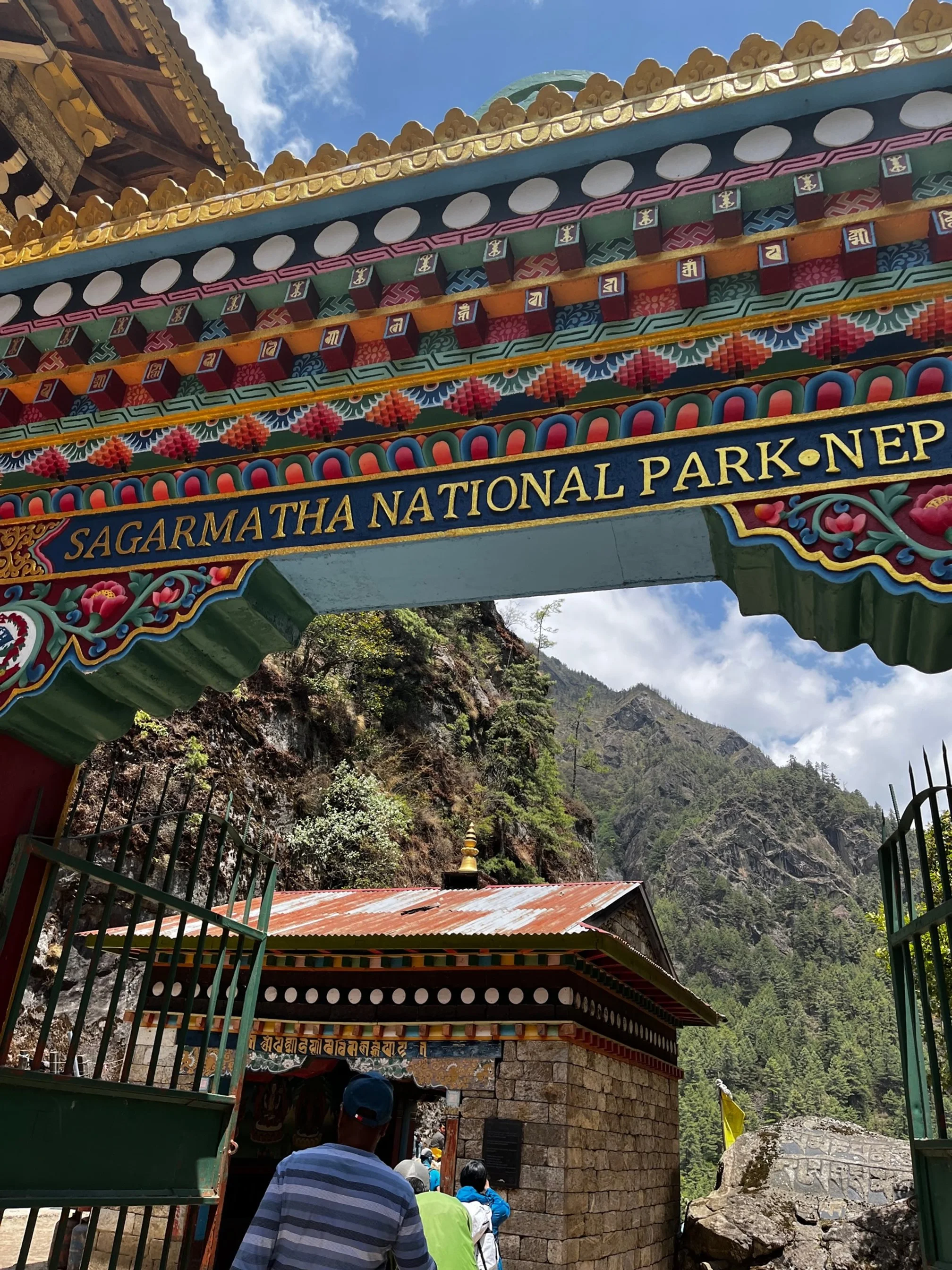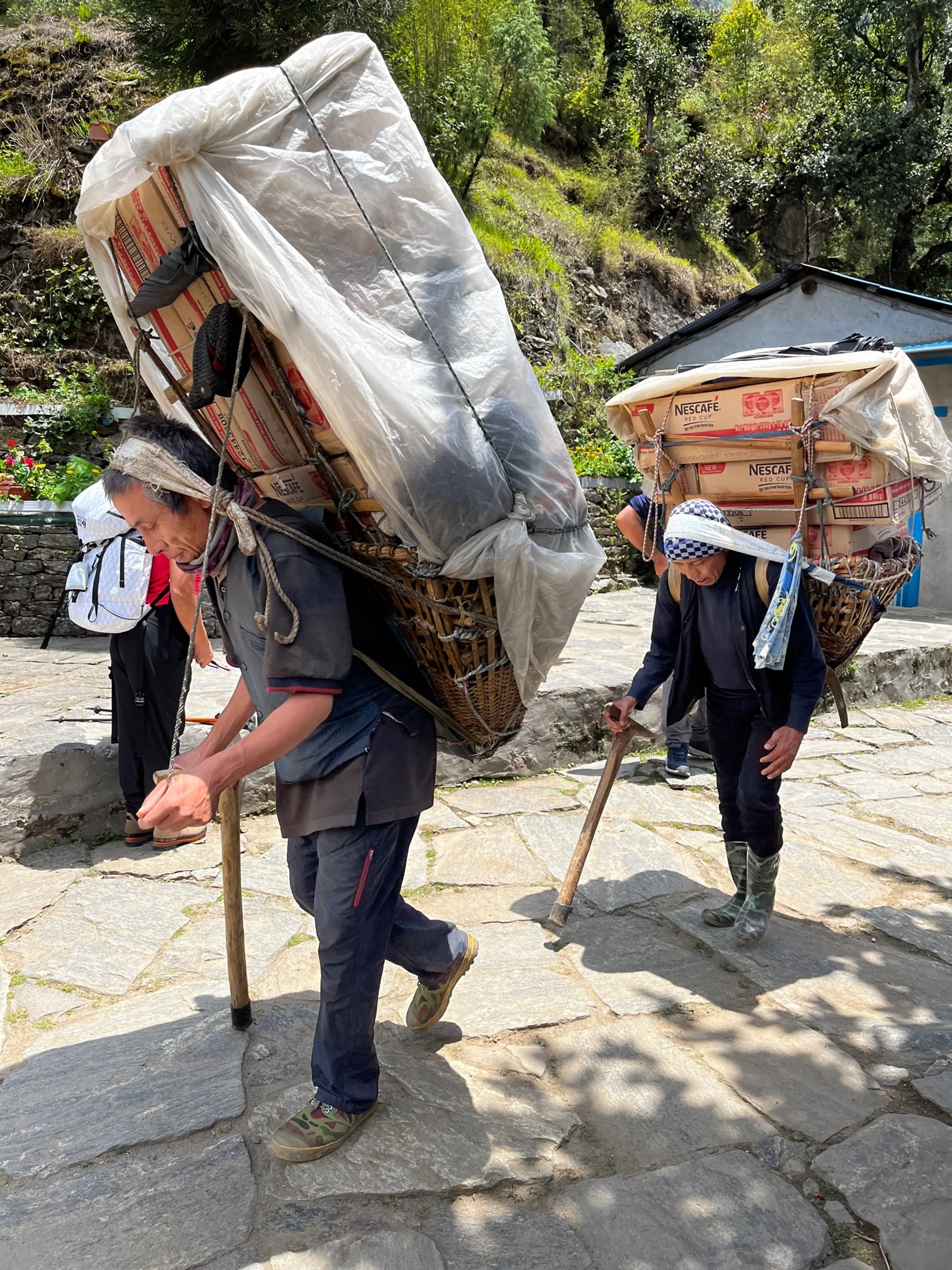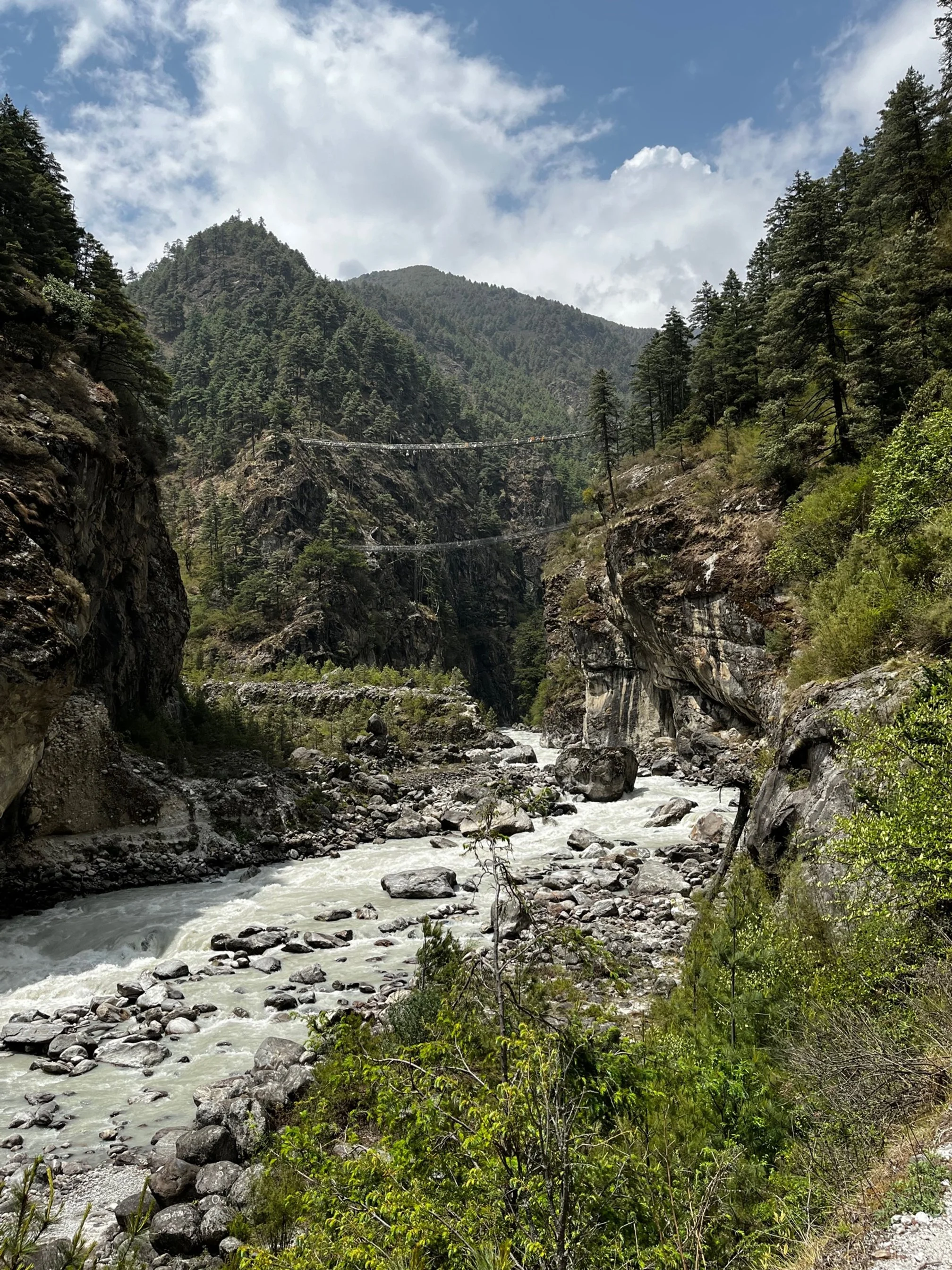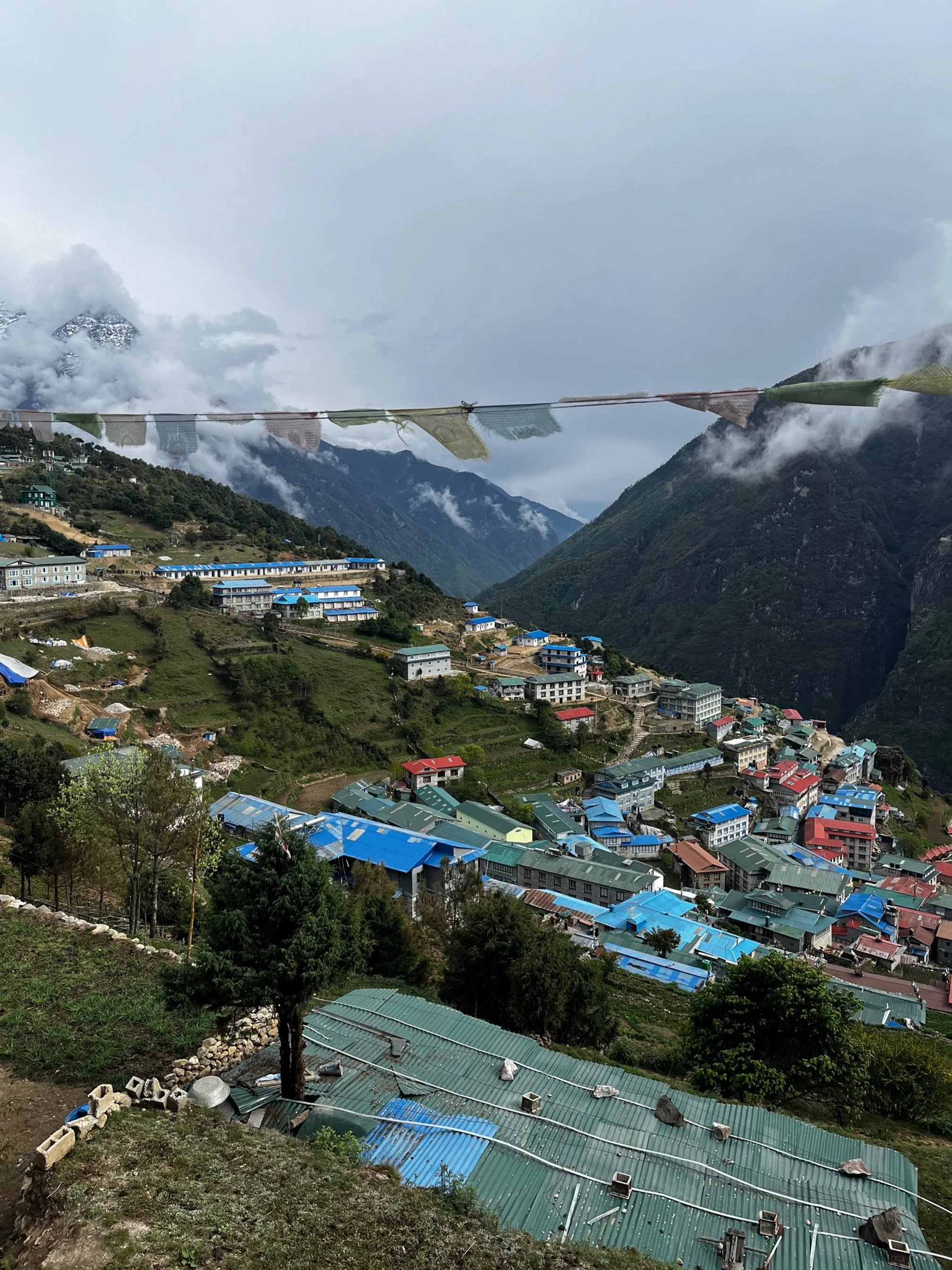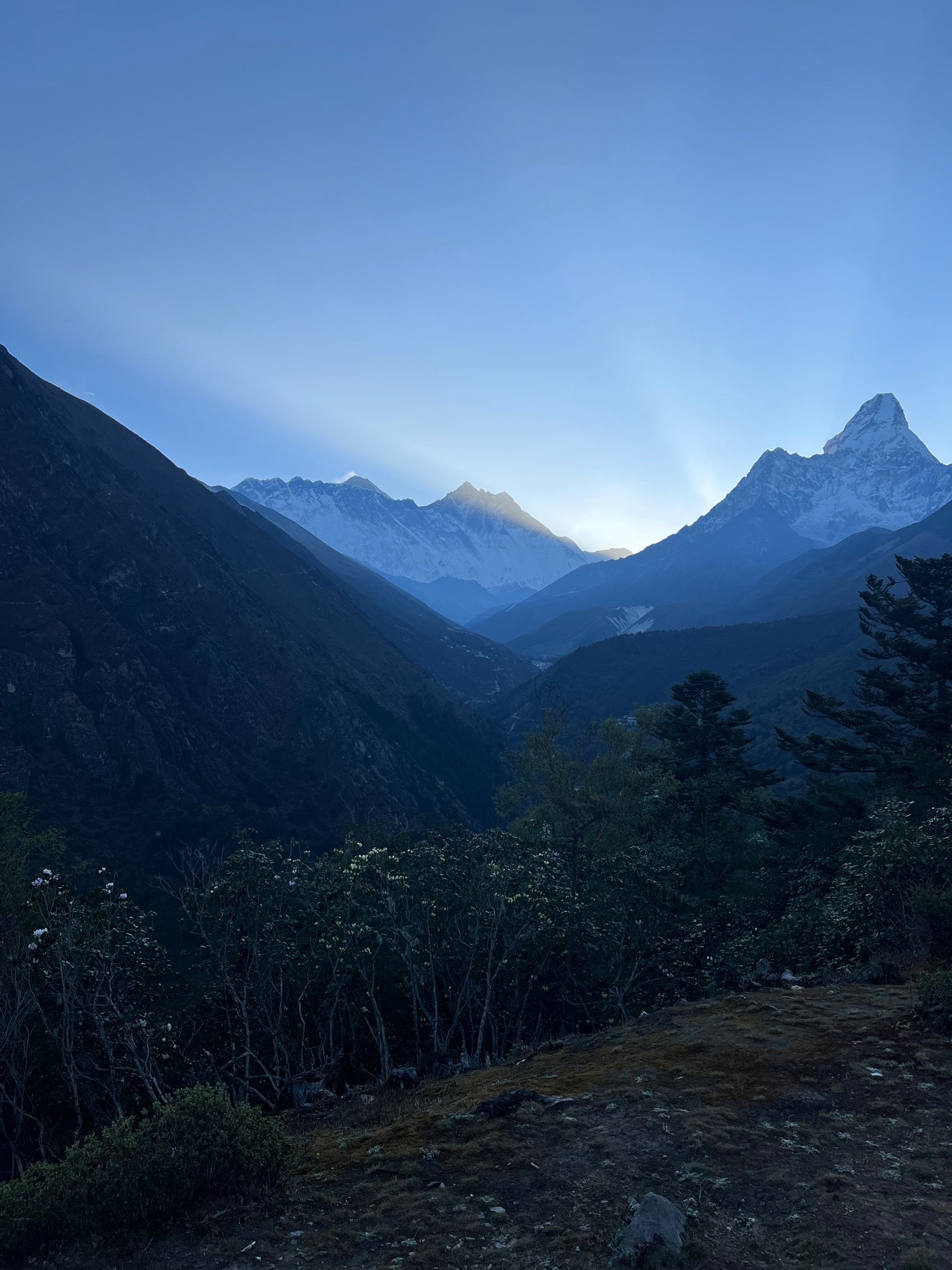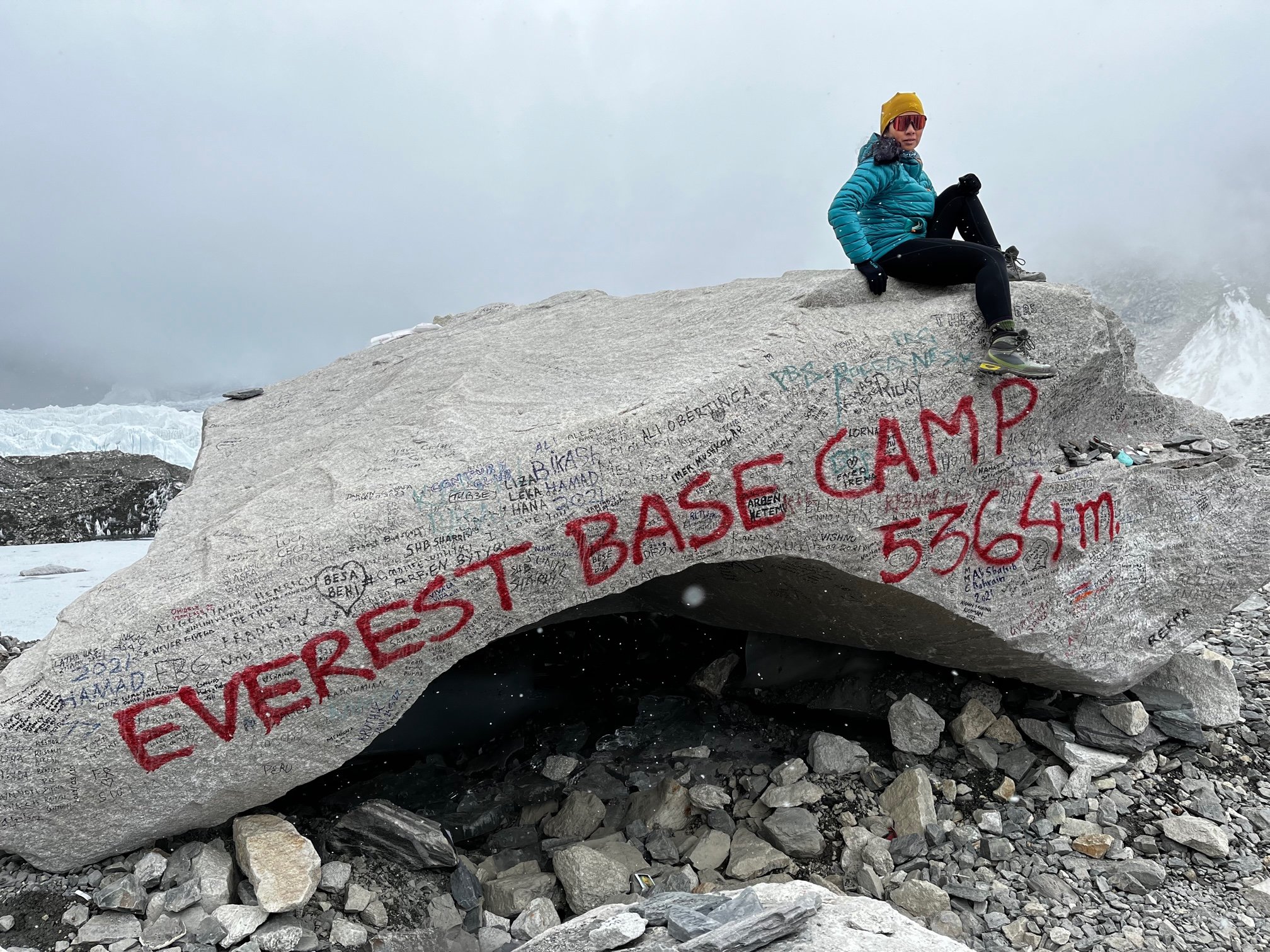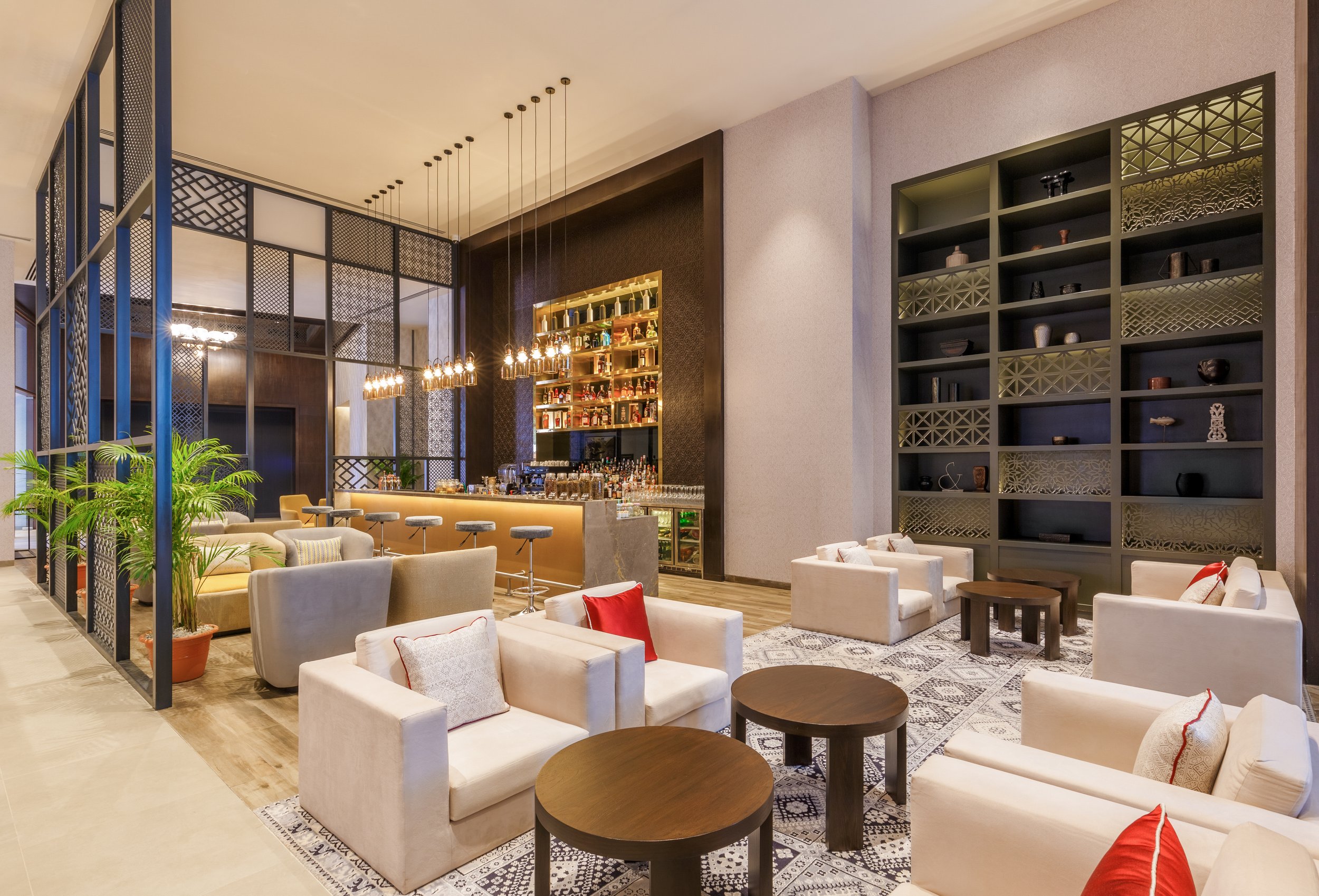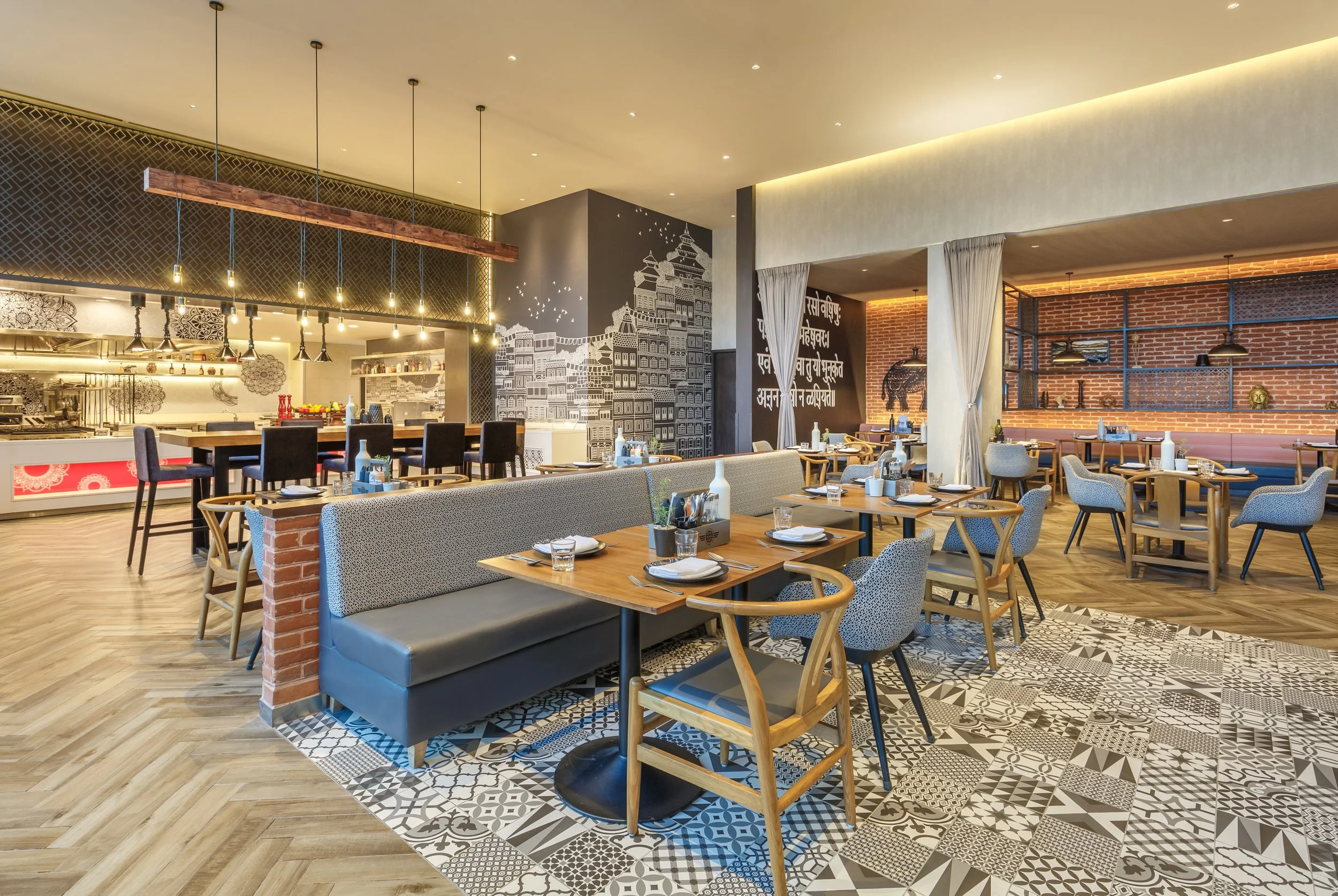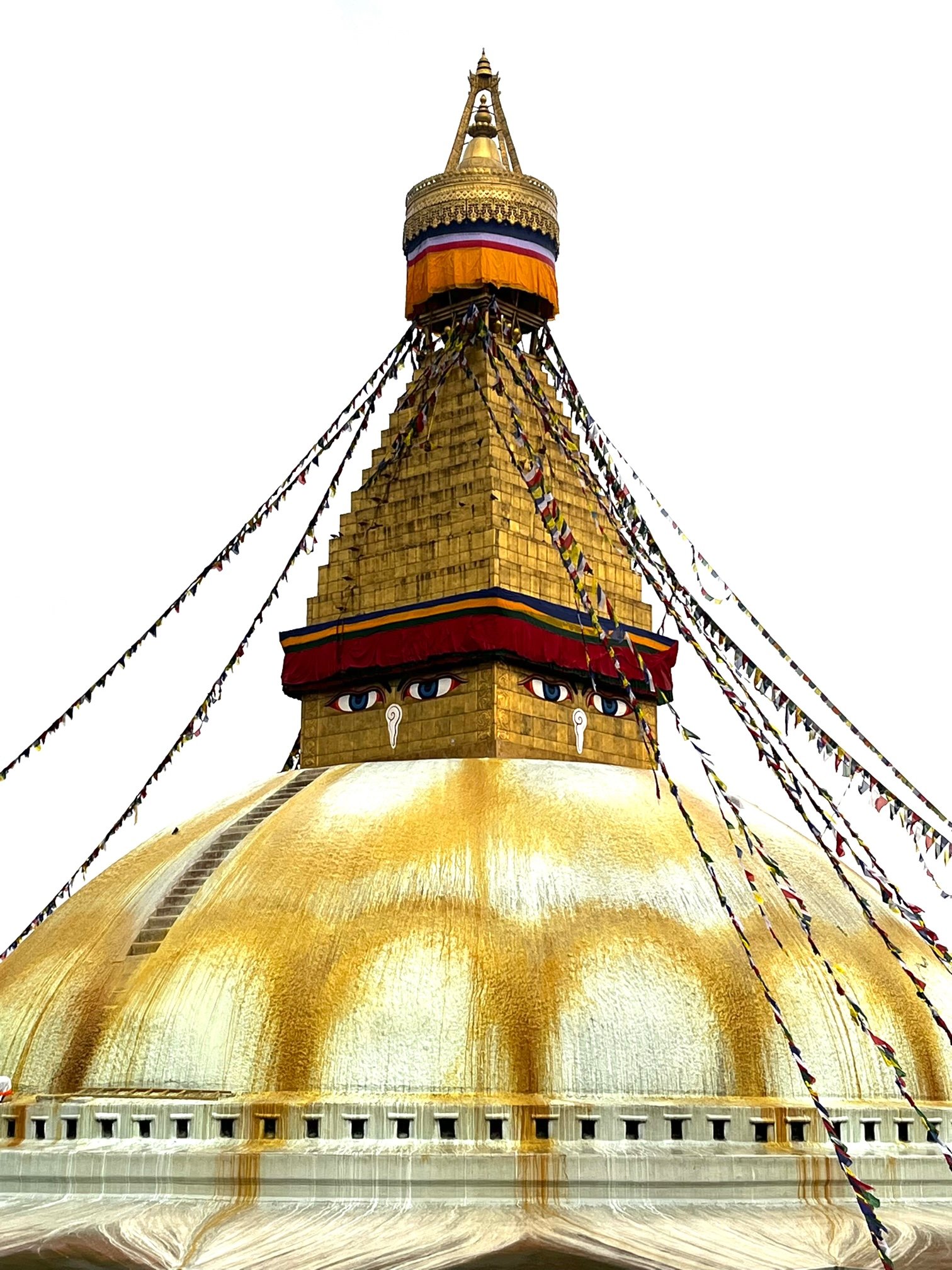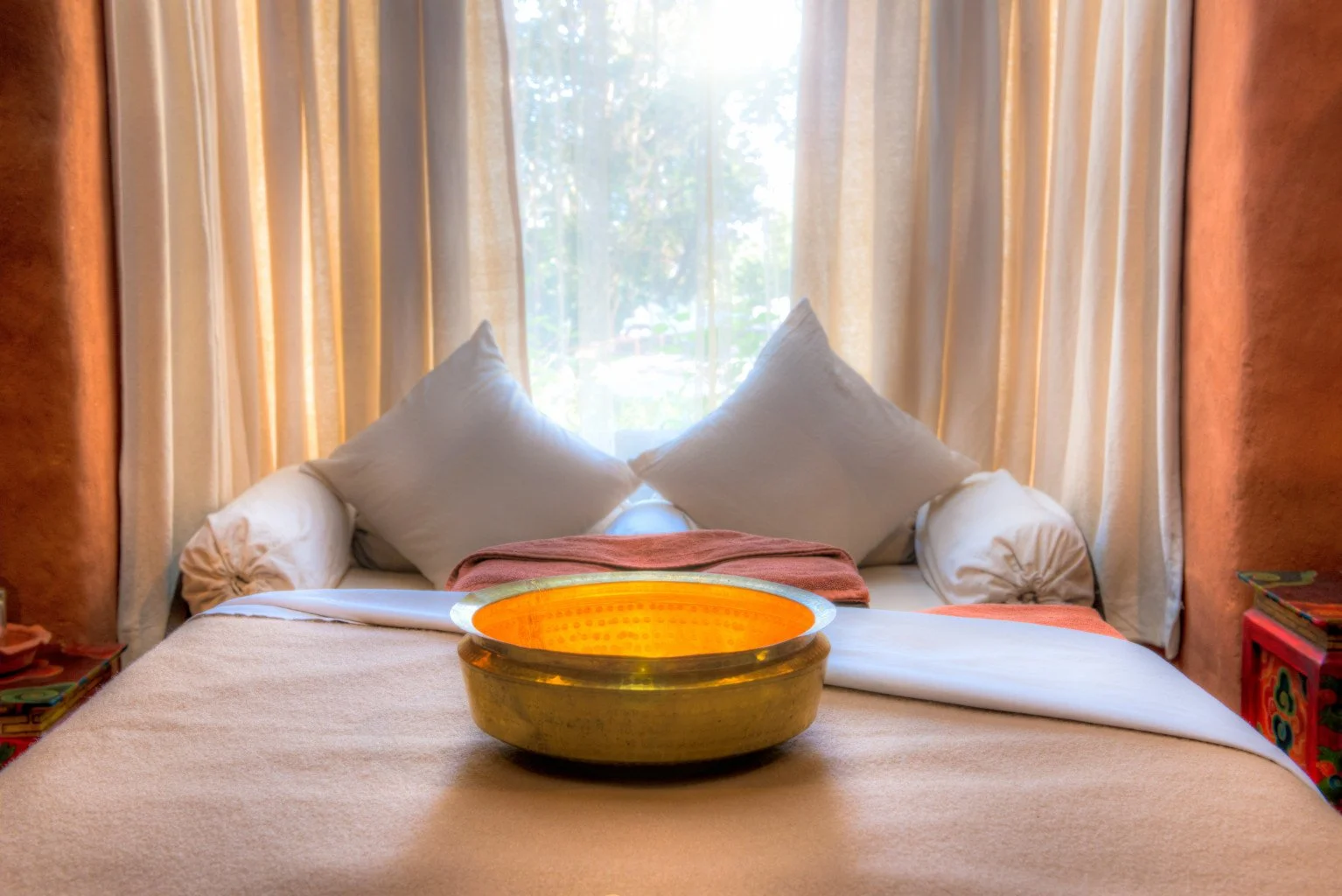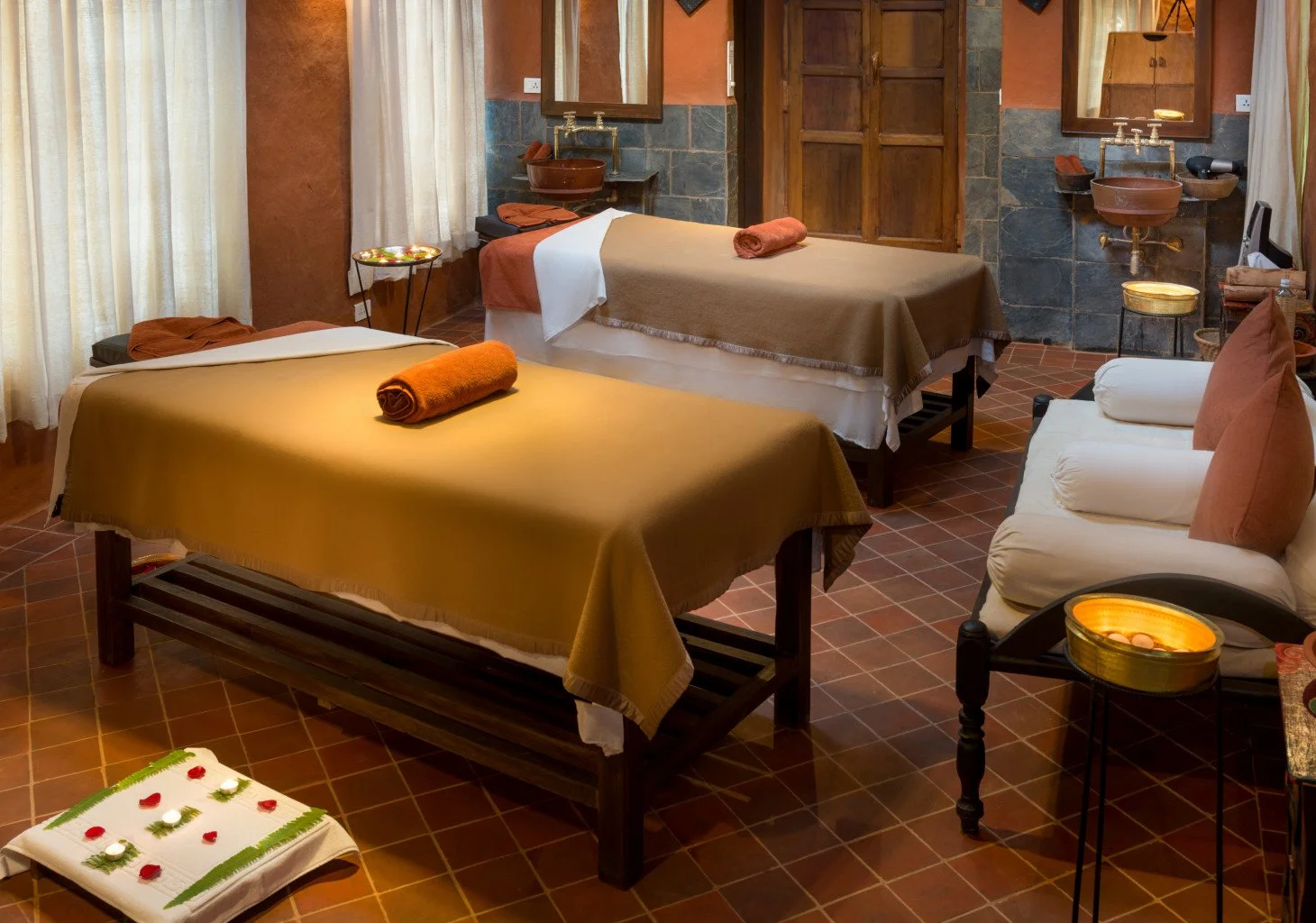The Eyes of Everest
It was late morning when our trekking group reached the colorful, traditional gate that marks the start of the Sagarmatha National Park. The Nepalese word for Mount Everest is Sagarmatha. It has many meanings, like “Sky” and “Head” or “Goddess of the Sky”. The Tibetan name for Mount Everest is Chomolungma, which means "Goddess Mother of the World." I was about to find the relevance of these names as I embarked on my journey to Base Camp and see, for my own eyes, the majestic Mount Everest. Around the side of this initial gate, is a plaque, engraved with the following: This traditional kani gate marks your entry into the beyul Khumbu - a sacred hidden valley of the Sherpa people. Khumbu is also a world renowned National Park and a World Heritage Site.While visiting this special area, visitors are encouraged to:
Refrain from taking life
Refrain from anger
Refrain from jealousy
Refrain from offending others
Refrain from taking excessive intoxicants
Beyul, in Tibetan, refers to sacred hidden valleys and Khumbu is the region of Nepal which encompasses Mount Everest. At the entry/exit of each Sherpa village there are similar, but less decorative gates to protect the village from any negativity that travelers could carry with them on their journeys. Buddhist prayer wheels of all sizes and varying decor line these gates, containing mantras. The mantra, Om mani padme hummeaning “jewel in the lotus”, is often inscribed on the outside and inside of the wheel. Villagers/travelers are encouraged to recite the mantra aloud, while turning each prayer wheel clockwise with their hand. This physical act of turning the prayer wheel is the equivalent to a person reciting a mantra. The Sherpa people have been the trusted patrons of Mount Everest, living and working – taking care of trekkers from all parts of the globe for centuries. In May, I was honored to be a part of their world for a brief moment. One of the first things I learned from our trusty G Adventures guide Suman, was that Sherpas and Porters are not one in the same. Porters carry 100-200 lbs (45-90kg) on their backs, hauling everything from mattresses and building supplies to trekkers' belongings, all while wearing flip flops. The lack of roads on the mountain combined with unpredictable weather, results in Porters being the only way supplies reach the Tea Houses (and the occasional helicopter).Sherpas are a revered ethnic group, that you are either born or married into. These are the knowledgeable guides who not only set the pace for groups of trekkers, but also act as the liaison at the Tea Houses, all owned by Sherpas. They run the mountain. Our Sherpa guide’s name was Lama (not like the animal, Ilama as I initially thought!). For our trek, Suman and Lama were in the front guiding our group, along with his trusty guide-in-training, Manjil, who supported the group from the middle and gathered the stragglers (like me!) at the end of the group.If I summarized this whole trip in a lesson, it would be in the Buddhist belief of non-attachment. This lesson is about being conducive to change and not being tied to any one thing including people, material goods and expectations. If you have spent any time in nature, you will know how the outdoors breeds a sense of non-attachment. In nature, things just are. Like, Mount Everest – the highest peak in the world – it was here long before we arrived, and will be here well after we leave this physical world.
Preparation
It was February 2022 when I floated the idea to my friend about trekking to Everest Base Camp. She agreed, reluctantly. We previously had a two-day adventure in 2017 summiting Mt Fuji, and the 12 day trek to Everest base camp seemed like a fantastic next adventure. I had connected with four friends who had all successfully completed the trek, the most recent being in January 2022. After looking into all the expedition companies, we chose G Adventures.
A mid-price point for the small group trek. Ours ended up being 13 people from Canada, US and the UK, with the average age being in their 30s. Besides knowing the basics and having a lengthy packing list, we were left to our own devices on preparation. For training, I kept on my usual routine with cardio and weights which varied from 3-5 days a week. I had read articles suggesting to get used to long hikes, walking for 5 hours straight, which is not entirely accurate. While we would walk that long, it was broken up with breaks. I would recommend that you need to be accustomed to carrying at least 8-10 lbs. of weight on your back, in addition to hiking for longer distances. Our porters carried 22 lbs (10kg) per person which helped a great deal. I did incorporate daily intermittent fasting, which helped me have a consistent level of energy. A suggestion from another friend who completed the trek, was to bring almost 10 lbs of snacks. While we could not comply due to weight restrictions, we definitely loaded up our packs with as much as we could. It was a great tip as the food variety along the trail was limited, expensive and sometimes expired.
On the Trail
After we lost a day due to bad weather, we took the short flight from Kathmandu to Lukla (2840 m). The runway is the shortest in the world (also the most dangerous) at 527 m, where the average runway is over 3000 m.We started our trek to Phakding which took 2.5 hours, where we spent the night. This was the shortest, and possibly the easiest day of the entire trek. Followed by the hardest (at least for me), trekking from Phakding to Namche Bazaar (3440 m). It was a combination of the heat, my heavy pack and the aggressive incline. By the end, my friend and I sat on our beds at the Tea House wondering if this was going to set the precedent for the entire trip. Thankfully, it did not. As we ascended, the incline had moments of leveling out before many more big stair climbs; the stairs were either rocks laid out or massive concrete steps. By the end of day two, I had reassessed what I was carrying in my pack. I made sure to only carry enough water to get me to the next rest stop and only a few snacks. On average, we were drinking between 3-4 L of water per day and became professionals at timing the water treatment drops. By the end of the journey, I grew tired of treating water and never grew accustomed to the treatment aftertaste.
At the Tea House in Namche Bazaar, we met a group of trekkers who were on their descent. Some of the group had turned back and while the others had opted to take a helicopter to base camp. This cast some doubt within our group. Luckily our fantastic guide, Suman, who regrouped us, sharing his expertise, encouraged us and reminded us that “We are all going to make it.”
We shared the trail with many animals including yaks, horses, mules and dzo, or as Suman called them, ‘yowls’ – a mix between a yak and a domestic cow. Hearing the bells through the early morning or along the trail never got old, and you knew to get out of the way. I welcomed the break to let the lines of animals or porters pass along the narrow paths. For the number of animals along, we were only caught once where we had to outrun some dzo before we were butted by their horns. That’s when the adrenaline kicked in, but Lama made sure we were ok. We kept a steady pace after that close call. A clear day at Tengboche (3860 m) meant we caught a glimpse of Everest and the neighboring Lhotse in the early morning daylight. And then the cold set in, and Suman warned us that “the mountain vacation was over.” The conditions were about to get real (my words, not his). Past 4000 m, everything changed. The weather, the terrain and even our mood. As we reached the desolate Dingboche (4350 m) we were feeling the effects of our altitude sickness medication. As a precaution before the trip, we brought Diamox in case we needed to take it during the trip for altitude sickness. Altitude sickness is a lot like feeling dehydrated or heat stroke– throbbing headache and loss of appetite. The catch is, if you are already feeling the symptoms, then it’s too late to actually take the medication. Alternatively, you could just be dehydrated. We were feeling good up until Namche and so we made the decision to take it after we left. I did receive late advice of incorporating a sauna for acclimatization, which might have helped. But, you really cannot predict how your body is going to react to the altitude.The main symptom I had was the tingling of my hands and feet. Which did not help that we were in a colder climate, causing me to worry about circulation. I remember piling on the wool socks and down slippers in my sleeping bag in the middle of the night – because I could not feel my feet. It had less to do with the cold, and more to do with the effects of the Diamox. The rest of the way up, the altitude definitely played a factor on the speed as a group. Though the incline didn’t feel that steep, there was an invisible force working against us. My oxygen saturations dropped to70%. At sea-level we would intubate people with oxygen saturations of 65-60%.
The Oasis of our Trek
The reward at the end of the days’ hike was always the warm meal and accomodations along the way. When we stumbled upon Café4410 in Dingboche, it surprised us. Although being quite stark on the outside, inside we were greeted by a flat screen TV, a proper espresso machine and a full-sized pizza oven. We walked in, and it could have been in a major city. You could tell it was an oasis in the middle of the mountain. The place was packed with international trekkers. The chocolate cake was not bad either. At each Tea House we stopped at, the menu stayed the same.
There was the consistent Dhal Bhat – lentils and rice with some pickles on the side and Sherpa Stew – a hearty stew with momo (dumpling) noodles. I made sure to eat something regardless if I felt like it or not. This was partly due to the altitude and loss of appetite. Sometimes dinner consisted of boiled potatoes with yak butter and pepper, other times it would be fried rice with egg rolls. I developed a taste for honey lemon ginger tea though. It was a nice way to warm up after a long day. The simple Tea House quarters included at least one spider, a communal toilet which may flush on its own or through the use of a water bucket, and from Dingboche upwards - one heated eating/lounge room with a fireplace fuelled either by gas or dried yak waste. Our individual rooms were never heated. A word on sanitation. We got used to stuffing our pockets with toilet paper and had hand sanitizer at arm’s reach at all times. By the time we reached the Base Camp on the 8th day, I was excited for the prospect of running hot water, available/free soap and toilet paper. Much to my surprise, gas powered hot showers were available and I took them when I could. They generally cost between $2.50-$10. The longest I went without a shower was 2 days and washing my hair was 4. It gave me a sense of normalcy in my foreign environment. It also gave me a way to support the Tea Houses along the trek.And then on the 8th day, we made it. Gorakshep (5180 m) was the final village, before making the final trek to the famous rock that marked the Base Camp at 5364 m.
We made it before the crowds of people started to arrive wanting their photo op. It snowed overnight, so we could not do the additional Kala Patthar hike (5644 m) to see an even better view of Everest. I was so tired; I was not disappointed that the hike was not on. Kala Patthar is a tough hike, higher in elevation and harder than the last leg of getting to Base Camp. Because we had initially lost a day, we had 8 days up and trekked for longer periods during our descent, making it 3 days down. By the time we had successfully reached base camp, we were happy to descend quickly. From Gorakshep, we went to Periche (4200 m) and then from Periche back to Namche Bazaar (3400 m) was 20 km and from Namche Bazaar back to Lukla (2840 m) was 22km.
Our Return
As we arrived back to Kathmandu, we checked into our home away from home at the Hyatt Place Kathmandu. The concierge was eager to hear about our trekking adventure and it was nice to see that they remembered us from weeks prior. The 6-month-old hotel welcomed us back with an impressive weekend brunch spread, in which our stomachs were too small for our eyes. I’ve stayed at many hotels, and the hotel restaurant is usually mediocre.
True to its name, Zing – World of Flavours, pulled all of the great food from India and Tibet, thanks to Head Chef Pandev Rakesh. In fact, even my photos of the traditional Idli, Mysore Bonda and Chole sent comments from abroad of fond memories. I wanted to try everything on the menu.
But as we sat in the dining room, we were hyper aware that we desperately needed a hot water shower. Coming back to the hotel after our trek, we utilized almost all of the amenities with the exception of the rooftop pool; the Wi-Fi, the laundry, shoe cleaning service, the room-service, restaurant and the gym. We were happy the hotel even offered a favorable money exchange for our convenience as most stores only took cash as well. Of course, trekking for 11 days made everything at the hotel that much sweeter and we were happy that the hotel could offer a respite from the busyness of Kathmandu and ease from the conditions on the trek.Located in the quiet area of Tahachal, Hyatt Place Kathmandu invites travelers looking for the comforts of home, with the accessibility to well-known sites, like The Patan Durbar Square and Bhaktapur Durbar Square (both UNESCO World Heritage Sites). Both are filled with Newari artisans, ancient temples and architecture from the Malla Dynasty (12-18thcentury). We spent our first few days around in the area, walking around and the hotel set us up with a driver to take us to nearby sights. I found my pink Himalayan sea salt in this small shop run by a mother/daughter duo called the Peacock Tea & Spice Shop at Dattatraya Square in Bhaktapur.
With no help from Google Maps and after searching a bit with locals on our last day, we were able to find Kar.ma Coffee. Kar.ma coffee works with over 900 (and growing) farmers and their families in Nepal. They source coffee directly from the farmers and help create a supportive community for all those involved. A subscription service for their coffee can be found on their website as well as other gift items. If you are visiting, there are two cafes, one in HUB, Boudha and the other is in Gyanmandala, Jhamsikhel.
To celebrate a successful trek to Everest Base Camp, we needed a spa visit. I initially found the magnificent Dwarika’s Hotel on Instagram and wanted to visit the Pancha Kosha Himalayan Spa located in the hotel.
What drew me in was the incredible architecture of the hotel. Created by Dwarika Das Shrestha, the hotel was built with handmade bricks and incorporates wood carvings, sculptures, bronze artifacts and terracotta. As soon as you pass the gateway to the hotel, you are transported into a Newari paradise. The hustle and bustle of Kathmandu is suddenly left behind and filled with serene surroundings with both Hinduism and Buddhism design elements.The Pancha Kosha Himalayan Spa incorporates Ayurveda, Buddhist medicine and traditional rituals and treatments. The focus is the Pancha Kosha- the 5 layers of being. Anamaya Kosha (the vital or food component), Pranayama Kosha (the energy or life force component), Manomaya Kosha (the mental or psychological concept) Vigyanmaya Kosha (the intellectual component) and the Anandamaya kosha (the pure bliss and happiness component). The spa menu is extensive and includes practices unique to the region, like Singing Bowl Therapy. We settled however on the Body Harmony combination which was a Himalayan Trekkers massage (only fitting) followed by a revitalizing herbal bath. When I entered the massive and beautifully decorated treatment room, complete with a queen size bed - I was immediately hit with a powerful, potent eucalyptus scent.
It was perfect for helping me clear my congested nose and throat thanks to the ‘Khumbu cough’ that I had acquired during the trek. I did not cough once during the entire treatment. The hot herbal bath, following the treatment, was a mixture of pink Himalayan salts, Rhododendron flowers and Juniper essential oils. The Nepali name of the bath salts is Lali Gurans. The Rhododendron flowers help to detox the skin and purify the skin's pores. The Juniper essential oils help relieve stress and work to strengthen the body’s immune system. I really enjoyed the herbal bath so I purchased two packs (I am already regretting that I did not buy more!) from the hotel shop. Once our time at the spa was complete, we wished that we could have added additional services to experience more of what Pancha Kosha Himalayan Spa had to offer, but of course the spa was booked solid. Thankfully, we were able to blissfully float to a 6-course meal (courses range from 6 to 22!) at the signature restaurant of the hotel, the Krishnarpan, and finished our night on a very happy and full note.From a trip that took four months in preparation, I look back on videos and photos and feel like it was a surreal experience. I have traveled to places all around the world, looking for adventure and cultural experiences and grateful that Nepal was all of this, and more. I realized, while some people travel to escape, this trip was proof, I travel to explore. It was a great experience to challenge myself through the lesson of non-attachment, enjoying the journey, rejoicing in reaching the destination and seeing the world through the eyes of Everest.
